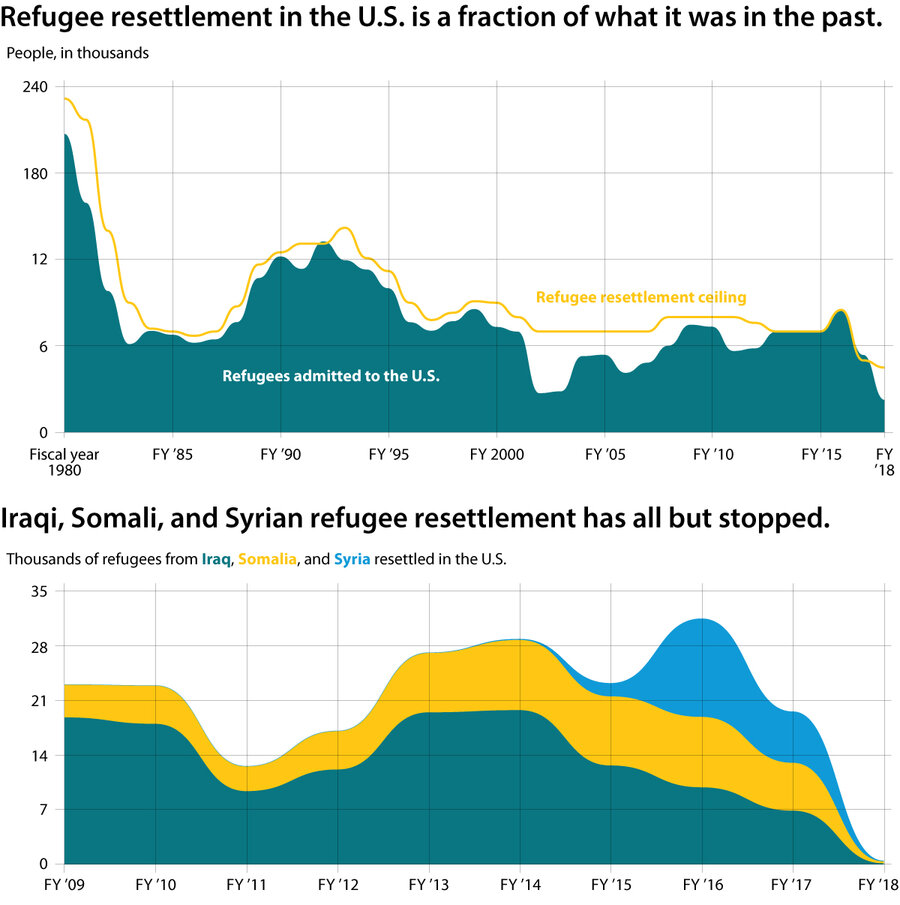As global refugees hit record highs, US welcomes record lows
Loading...
As the world’s refugees number a record 25.9 million, the U.S. is welcoming in historic lows since the modern refugee program began in 1980. This week, the Trump administration is considering another cut to refugee admissions for the upcoming fiscal year – or scrapping the program entirely.
The White House’s consideration has raised worries among resettlement experts. Besides humanitarian concern for those who may never reach the U.S., experts also warn of consequences for already resettled refugees and implications for the communities they’ve helped revitalize.
Why We Wrote This
Many factors move the needle on refugee admissions. In the U.S., tensions are growing over balancing humanitarian outreach with an increasingly closed-borders political climate.
Research shows that refugees’ economic contributions to American communities outweigh the initial costs to resettle them. Refugees in southeast Michigan generated around 2,000 jobs in 2016 alone, according to a recent study by Global Detroit.
In fact, Global Detroit director Steve Tobocman sees local-level collaborations that root for immigrants’ success as an emerging trend. He says there’s a “huge growth of community and economic development leaders who are thinking of their own self-interest from the region … who have embraced refugee resettlement and immigration as a strategy really to revitalize their economies.”
Salai Lungngam had two strikes against him in Myanmar: ethnic minority Chin and religious minority Christian. His activism against the Burmese government eventually led him to flee the country for his life. By way of India then Malaysia, he resettled as a refugee in the United States 10 years ago.
The Hoosier State has resettled at least 12,804 Burmese refugees since 2007. Mr. Lungngam arrived in Indianapolis with about $50. Now a real estate broker, he’s sold around 180 houses since 2016. He says 8 out of 10 of those homeowners have been fellow refugees. “These refugees are not draining the resources of the government,” says Mr. Lungngam, now a U.S. citizen. Instead, they’re “really helping the community.”
As the world’s refugees number a record 25.9 million, the U.S. is welcoming in historic lows since the modern refugee program began in 1980. The Trump administration is considering another cut to refugee admissions for the upcoming fiscal year – or scrapping the program entirely.
Why We Wrote This
Many factors move the needle on refugee admissions. In the U.S., tensions are growing over balancing humanitarian outreach with an increasingly closed-borders political climate.
“It’s hard to see how this can be advancing our nation’s foreign-policy goals or our humanitarian goals,” says Mark Greenberg, senior fellow at the left-leaning Migration Policy Institute.
Nayla Rush, a senior researcher at the right-leaning Center for Immigration Studies, argues for capping refugee admissions at 15,000 to focus on the United Nations’ urgent and emergency refugee submissions.
The program “just needs to be rightly applied, as a ticket out only for those refugees who are genuinely at risk in the countries they’ve fled to,” Dr. Rush wrote on the CIS blog.
The White House’s consideration has raised worries among resettlement experts. Besides humanitarian concern for refugees who may never reach the U.S., they also warn of consequences for already resettled refugees and implications for the communities they’ve helped revitalize.
Humanitarian concern
When President Barack Obama left office, the annual ceiling for refugee admissions was set at 110,000 for fiscal year 2017. President Trump reduced the cap the following year to 45,000, then down to 30,000 for 2019.
White House officials will convene Tuesday to discuss the refugee totals for the next fiscal year, which begins Oct. 1. Some officials argue for lowering the cap to focus on security concerns and capacity to offer humanitarian protection to asylum-seekers, Politico reported.
“My focus right now is trying to manage the crisis at the border for us and keep those asylum backlogs from growing,” acting U.S. Citizenship and Immigration Services Director Ken Cuccinelli told CNN. Border agents have been overwhelmed with immigration traffic at the southern border, and U.S. immigration courts face a backlog of around 1 million cases.
Unlike asylees, refugees apply for protection before they’ve reached the U.S. Some migration experts say the country must address the increased asylum claims while also responding to refugee resettlement needs.
“They should not be pitted against each other,” says Mr. Greenberg.
Economic impact
Cole Varga, executive director of Exodus Refugee Immigration in Indianapolis, sees a financial downside to family separation. Some refugee families are waiting for wage earners to join them, such as a spouse or other adult relatives.
“The more people you have locally relying on each other, building assets, building income, the more successful they will be long term,” says Mr. Varga. The reduction of refugee admissions under the current administration forced him to let go of 15 employees – nearly a third of his staff at his refugee resettlement organization. Similar nonprofits have shuttered entire offices.
Research shows that refugees’ economic contributions to American communities outweigh the initial costs to resettle them. Refugees in southeast Michigan generated around 2,000 jobs in 2016 alone. The study by nonprofit Global Detroit and the University of Michigan also found that within a decade refugees there generated between $229.6 million and $295.3 million in new spending – a boon to a region hit hard by the struggles of Detroit’s auto industry.
Global Detroit director Steve Tobocman sees local-level collaborations that root for immigrants’ success as an emerging trend.
Mr. Tobocman says there’s a “huge growth of community and economic development leaders who are thinking of their own self-interest from the region … who have embraced refugee resettlement and immigration as a strategy really to revitalize their economies.”









